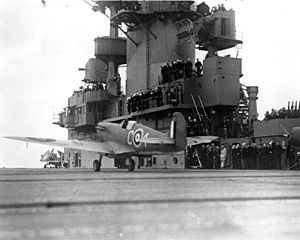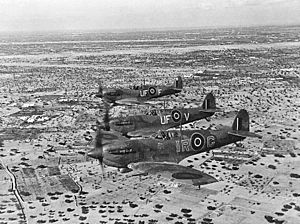Operation Calendar facts for kids
Quick facts for kids Operation Calendar |
|
|---|---|
| Part of the Battle of the Mediterranean of World War II | |
 A Spitfire takes off from USS Wasp. |
|
| Objective | To send Supermarine Spitfire planes to help Allied forces defending Malta. |
| Date | 20 April 1942 |
| Executed by | |
| Outcome | The Spitfire planes were delivered successfully. However, most were destroyed almost immediately on the ground. |
Operation Calendar was a secret mission during World War II in 1942. It was a joint effort by the British and American forces. Their goal was to deliver Supermarine Spitfire fighter planes to the island of Malta. Malta badly needed these planes to defend itself from strong air attacks by the enemy.
Contents
Why Malta Was So Important
Malta is a small island in the Mediterranean Sea. During World War II, it was a very important base for the Allied forces. It was like a giant aircraft carrier that couldn't be sunk! Because of its location, it could control shipping routes. This made it a key target for the Axis (Germany and Italy).
The Axis powers bombed Malta very heavily. They wanted to take control of the island. Malta's defenders needed more fighter planes to protect themselves. But fighter planes couldn't fly all the way to Malta from Britain. They had a short flying range.
The "Club Run" Idea
To solve this problem, the Allies came up with a plan called "Club Run." This meant loading the fighter planes onto an aircraft carrier. The carrier would sail close enough to Malta. Then, the planes would take off from the carrier and fly the rest of the way to the island.
Several "Club Runs" had happened before. But by 1942, the British didn't have a suitable aircraft carrier available. The situation in Malta was very urgent. So, the British Prime Minister, Winston Churchill, asked American President Franklin D Roosevelt for help. President Roosevelt agreed to lend the American aircraft carrier USS Wasp for this important mission.
The Mission Begins
The USS Wasp picked up 52 Spitfire planes from Shieldhall, Scotland. Pilots from No. 601 Squadron RAF and No. 603 Squadron RAF were also on board. These were Spitfire Vc models. They had extra fuel tanks to help them fly further.
However, the planes were not perfectly ready. Some of the external fuel tanks leaked. This was a common problem on these "Club Runs." Also, many of the planes' guns didn't work, and some radios were faulty. The Spitfires were originally painted for desert camouflage. But they were quickly repainted dark blue. This was to help them blend in with the sea during their long flight.
The Journey to Malta
The Wasp left Glasgow, Scotland, on April 14, 1942. It was escorted by American destroyers USS Lang and Madison. A British battlecruiser, HMS Renown, and its escorts joined them later. This group of ships was called Force W.
On the night of April 18–19, Force W passed Gibraltar. More British ships joined them there. These included cruisers HMS Charybdis and Cairo, and several destroyers. During the final checks, the problems with the planes' guns and radios were found. But it was too late to fix them.
Planes Take Off
On April 20, 1942, the mission began. The Wasps own planes, Grumman F4F Wildcats, flew overhead to protect the carrier. Then, 47 Spitfires took off from the Wasps deck.
Sadly, an accident happened during the take-off. An RAF mechanic was killed when he accidentally walked into a spinning propeller of one of the Spitfires. Several pilots waiting to take off saw this tragic event.
Most of the Spitfires landed safely in Malta. The planes from No. 601 Squadron landed at Luqa airfield. Almost all of No. 603 Squadron's planes arrived safely at Ta'Qali airfield.
One Pilot's Detour
One pilot, Sergeant Bud Walcott, an American, did not make it to Malta. He made an emergency landing south of the Atlas Mountains in Algeria. He was later held by the French authorities there. He eventually returned to the United Kingdom and joined the United States Army Air Forces.
What Happened Next
The new Spitfires were supposed to help Malta's defenses. But the German air force, the Luftwaffe, knew they were coming. Within minutes of the Spitfires landing, the Luftwaffe bombed Ta'Qali airfield. Most of the new planes were still on the ground. Within two days, almost all of them were destroyed.
The Governor of Malta, Lieutenant General Sir William Dobbie, reported that the situation on the island was very bad. He was soon replaced by Lord Gort. The British felt that the new Spitfires should have been better protected.
However, the Allies learned from this mission. The next "Club Run," called Operation Bowery, was much better planned and carried out.


